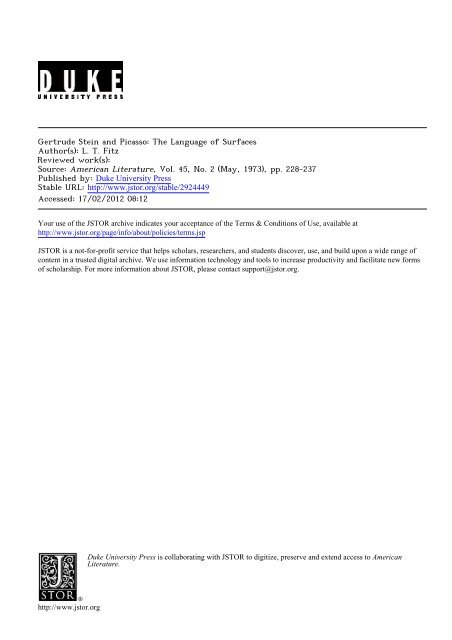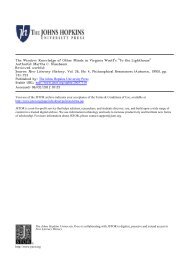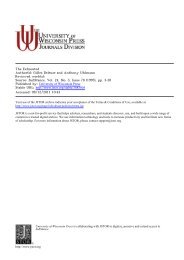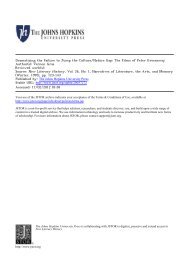Gertrude Stein and Picasso: The Language of Surfaces - engl328
Gertrude Stein and Picasso: The Language of Surfaces - engl328
Gertrude Stein and Picasso: The Language of Surfaces - engl328
Create successful ePaper yourself
Turn your PDF publications into a flip-book with our unique Google optimized e-Paper software.
<strong>Gertrude</strong> <strong>Stein</strong> <strong>and</strong> <strong>Picasso</strong>: <strong>The</strong> <strong>Language</strong> <strong>of</strong> <strong>Surfaces</strong><br />
Author(s): L. T. Fitz<br />
Reviewed work(s):<br />
Source: American Literature, Vol. 45, No. 2 (May, 1973), pp. 228-237<br />
Published by: Duke University Press<br />
Stable URL: http://www.jstor.org/stable/2924449 .<br />
Accessed: 17/02/2012 08:12<br />
Your use <strong>of</strong> the JSTOR archive indicates your acceptance <strong>of</strong> the Terms & Conditions <strong>of</strong> Use, available at .<br />
http://www.jstor.org/page/info/about/policies/terms.jsp<br />
JSTOR is a not-for-pr<strong>of</strong>it service that helps scholars, researchers, <strong>and</strong> students discover, use, <strong>and</strong> build upon a wide range <strong>of</strong><br />
content in a trusted digital archive. We use information technology <strong>and</strong> tools to increase productivity <strong>and</strong> facilitate new forms<br />
<strong>of</strong> scholarship. For more information about JSTOR, please contact support@jstor.org.<br />
http://www.jstor.org<br />
Duke University Press is collaborating with JSTOR to digitize, preserve <strong>and</strong> extend access to American<br />
Literature.
<strong>Gertrude</strong> <strong>Stein</strong> <strong>and</strong> <strong>Picasso</strong>: <strong>The</strong> <strong>Language</strong><br />
<strong>of</strong> <strong>Surfaces</strong><br />
L. T. FITZ<br />
University <strong>of</strong> Alber ta<br />
GERTRUDE STEIN saw Pablo <strong>Picasso</strong>'s development in terms <strong>of</strong> a<br />
struggle. This was the struggle with the problem <strong>of</strong> what is<br />
seen, the struggle "not to express the things he did not see, that is<br />
to say the things everybody is certain <strong>of</strong> seeing but which they do<br />
not really see."1<br />
<strong>Picasso</strong>, <strong>Stein</strong> points out, is not like other painters in his use <strong>of</strong><br />
technique. She sets him <strong>of</strong>f from Courbet, the foremost exponent<br />
<strong>of</strong> photographic realism in painting, <strong>and</strong> even from Matisse, who<br />
is probably the co-founder, with <strong>Picasso</strong>, <strong>of</strong> modern art:<br />
One day they asked Matisse if, when he ate a tomato, he saw it as he<br />
painted it. No, said Matisse, when I eat it I see it as everybody sees it <strong>and</strong><br />
it is true from Courbet to Matisse, the painters saw nature as every one<br />
sees it <strong>and</strong> their preoccupation was to express that vision, to do it with<br />
more or less tenderness, sentiment, serenity, penetration but to express<br />
it as all the world saw it. . . . But <strong>Picasso</strong> was not like that, when he<br />
ate a tomato the tomato was not everybody's tomato, not at all <strong>and</strong> his<br />
effort was not to express in his way the things seen as every one sees<br />
them, but to express the thing as he was seeing it.2<br />
<strong>Stein</strong> seems to be saying that these other painters used an avantgarde<br />
technique to express, however obliquely, something that could<br />
be expressed by any technique-namely, the natural world as they<br />
<strong>and</strong> everyone else thought they saw it. But <strong>Picasso</strong> used his unusual<br />
technique not to enhance an old vision <strong>of</strong> reality but to delineate<br />
a new one. And what was this vision <strong>of</strong> reality? <strong>Stein</strong> tells us:<br />
Really most <strong>of</strong> the time one sees only a feature <strong>of</strong> a person with whom<br />
one is, the other features are covered by a hat, by the light, by clothes<br />
for sport <strong>and</strong> everybody is accustomed to complete the whole entirely<br />
from their knowledge, but <strong>Picasso</strong> when he saw an eye, the other one<br />
1 <strong>Stein</strong>,<br />
<strong>Picasso</strong> (Boston, 1959), p. I9.<br />
2 Ibid., p. I 7.
<strong>Gertrude</strong> <strong>Stein</strong> <strong>and</strong> <strong>Picasso</strong> 229<br />
did not exist for him <strong>and</strong> only the one he saw did exist for him <strong>and</strong> as a<br />
painter.... he was right, one sees what one sees, the rest is a reconstruction<br />
from memory <strong>and</strong> painters have nothing to do with reconstruction,<br />
nothing to do with memory, they concern themselves only with visible<br />
things.3<br />
<strong>Picasso</strong>'s vision is instinctively patterned on an epistemology not<br />
unlike Hume's-we assume that a pr<strong>of</strong>ile has another eye because <strong>of</strong><br />
memory-we remember that every time we have observed a oneeyed<br />
pr<strong>of</strong>ile in the past, the person has turned to us <strong>and</strong> disclosed<br />
a second eye. <strong>Picasso</strong>'s "struggle," according to <strong>Stein</strong>, was with the<br />
problem <strong>of</strong> whether to put faith into pictures. Should he, by suggesting<br />
roundness, call upon the viewer's faith in the "other side" <strong>of</strong> a<br />
human body, or should he let pictures be flat painted surfaces to<br />
represent natural objects as they really are seen? <strong>Picasso</strong> was presented<br />
with the problem <strong>of</strong> whether to suggest the existence <strong>of</strong> a<br />
second eye by giving roundness to a face in pr<strong>of</strong>ile or to paint the<br />
pr<strong>of</strong>ile flat, with the frank confession that this is all we actually see<br />
in real life, "everything a human being can know at each moment<br />
<strong>of</strong> his existence <strong>and</strong> not an assembling <strong>of</strong> all his experiences."4<br />
Having conceived <strong>Picasso</strong>'s struggle along these lines, <strong>Stein</strong> saw<br />
his development as being mainly from cubism to flat surfaces <strong>and</strong><br />
lines. For cubism hinted at something unseen: namely, the back <strong>of</strong><br />
the cube, which has to be reconstructed from the viewer's memory<br />
<strong>of</strong> cubes. ("After all one must know more than one sees <strong>and</strong> one<br />
does not see a cube in its entirety."5) <strong>Picasso</strong> finally arrived at what<br />
<strong>Stein</strong> calls "realization" when he began to paint strictly in two dimensions<br />
with no hint <strong>of</strong> a third.6 Lines became a prominent feature<br />
<strong>of</strong> his art. A two-dimensional concept had replaced the threedimensional<br />
concept <strong>of</strong> cubes. Faith had been removed from his<br />
painting. All that was there was what we really see.<br />
In order to develop this theory <strong>of</strong> <strong>Picasso</strong>'s evolution from cubism<br />
to flat surfaces, it was necessary for <strong>Stein</strong> to account for the presence<br />
<strong>of</strong> many other trends in <strong>Picasso</strong>'s development which definitely<br />
do not amount to any linear evolution <strong>of</strong> style. After <strong>Picasso</strong> left<br />
cubism, for example, he did not go immediately to flat surfaces but<br />
3Ibid., p. I5.<br />
4 Ibid., p. 35.<br />
5 Ibid.<br />
6Ibid., p. 36.
230 American Literature<br />
instead entered into a long stylistic period chiefly characterized by<br />
rounded forms showing Italian influence. Such deviations from the<br />
path <strong>of</strong> true flatness <strong>Stein</strong> regards as periods <strong>of</strong> relaxation from the<br />
struggle, periods outside the mainstream <strong>of</strong> <strong>Picasso</strong>'s stylistic development.<br />
Of these temporary sidetracks in <strong>Picasso</strong>'s development,<br />
<strong>Stein</strong> remarks,<br />
African art like the other influences which at one time or another<br />
diverted <strong>Picasso</strong> from the way <strong>of</strong> painting which was his, African art<br />
<strong>and</strong> his French cubist comrades were rather things that consoled <strong>Picasso</strong>'s<br />
vision than aided it. . <strong>The</strong>y wished to lead <strong>Picasso</strong> away from his real<br />
vision.'<br />
After these periods <strong>of</strong> seduction away from his true course, <strong>Stein</strong><br />
tells us, <strong>Picasso</strong> began his struggle again:<br />
Each time that <strong>Picasso</strong> commenced again he recommenced the struggle<br />
to express in a picture the things seen without association but simply<br />
as things seen <strong>and</strong> it is only the things seen that are knowledge for<br />
<strong>Picasso</strong>.8<br />
<strong>The</strong>oretically, it should be possible to see all <strong>of</strong> <strong>Picasso</strong>'s work as<br />
"true <strong>Picasso</strong>" <strong>and</strong> not merely as sidetracks. But <strong>Stein</strong>'s selection <strong>of</strong><br />
important periods is interesting to us because it sheds light on her<br />
own work. It is my feeling that this cubist-flatness struggle which<br />
<strong>Stein</strong> saw as being so important to <strong>Picasso</strong> is present in her own<br />
work <strong>and</strong> is one key to her sometimes puzzling style.<br />
<strong>The</strong>re are, I believe, three things which <strong>Stein</strong>'s style shares with<br />
<strong>Picasso</strong>'s: (i) a cubist approach; (2) a style which concentrates on<br />
what is seen rather than what is remembered; <strong>and</strong> (3) a calligraphic<br />
or nonsymbolic concept <strong>of</strong> language. Let us take up these characteristics<br />
one at a time.<br />
<strong>Stein</strong> quickly grasped what there was about cubism' that was so<br />
7 Ibid., p. I 9.<br />
8 Ibid., p. 35-<br />
9 Several critics (e.g., John Malcolm Brinnin in <strong>The</strong> Third Rose: Gertrtde <strong>Stein</strong> <strong>and</strong><br />
Her Wor-ld, Boston, I959, or Michael J. H<strong>of</strong>fman in <strong>The</strong> Developinent <strong>of</strong> Abstractionism in<br />
the Writings <strong>of</strong> Gentrtrde <strong>Stein</strong>, Philadelphia, I966) have noted the affinities <strong>of</strong> <strong>Stein</strong>'s style<br />
with cubism. <strong>The</strong> comparison is usually extended mainly to the supposed jettisoning <strong>of</strong> subject<br />
matter by both <strong>Stein</strong> <strong>and</strong> the cubists. That either cubist paintings or <strong>Stein</strong>'s writings lack<br />
subject matter seems to me to be open to question. A number <strong>of</strong> critics, <strong>of</strong> course, have<br />
noted obvious connections between <strong>Stein</strong>'s writing <strong>and</strong> the visual arts in general; Michael J.<br />
H<strong>of</strong>fman, for example, points out her borrowing <strong>of</strong> the terms "portrait," "l<strong>and</strong>scape," <strong>and</strong>
<strong>Gertrude</strong> <strong>Stein</strong> <strong>and</strong> <strong>Picasso</strong> 23I<br />
pr<strong>of</strong>oundly different from all other art that had gone before it-its<br />
sameness from corner to corner, its total lack <strong>of</strong> a focal point:<br />
<strong>The</strong> composition <strong>of</strong> this war, I9I4-I9I8, was not the composition <strong>of</strong><br />
all previous wars, the composition was not a composition in which there<br />
was one man in the centre surrounded by a lot <strong>of</strong> other men but a composition<br />
that had neither a beginning nor an end, a composition <strong>of</strong> which<br />
one corner was as important as another corner, in fact the composition<br />
<strong>of</strong> cubism.10<br />
Like cubism, <strong>Stein</strong>'s fiction lacks a focal point <strong>of</strong> action; it lacks<br />
a climax. Her stories have a sameness throughout that makes them<br />
more portraits than stories. In Melanctha, for example, the plot is<br />
obviously not meant to hold us. <strong>The</strong>re is no suspense. <strong>The</strong>re are no<br />
real surprises. <strong>The</strong> interest lies in the characters <strong>of</strong> Melanctha <strong>and</strong><br />
Jeff. Character is unfolded gradually, <strong>and</strong> through much repetition<br />
(<strong>Stein</strong> calls it "insistence").1" Every page is literally as important<br />
to the work as every other page, just as every part <strong>of</strong> a cubist painting<br />
is as important as every other part. This technique is a perfect<br />
one for presenting what <strong>Stein</strong> is trying to present: "<strong>The</strong> theme [<strong>of</strong><br />
Three Lives, which contains Melanctha] . . . is an essentially new<br />
one: the theme <strong>of</strong> how little real progress or development there is in<br />
most human lives, how much repetition.."12<br />
<strong>Stein</strong>'s autobiographical writing shows the same lack <strong>of</strong> focal<br />
point: "Nothing is more notable about her autobiographical writings<br />
than how, whether she is dealing with her house, her books, her<br />
dogs, her pictures, her family, her friends, or even a good meal she<br />
has enjoyed, none <strong>of</strong> these items makes a more salient impression on<br />
the page than any other."13<br />
"In the three novels written in this generation that are the important<br />
things written in this generation," <strong>Stein</strong> tells us, "there is,<br />
in none <strong>of</strong> them a story. <strong>The</strong>re is none in Proust in <strong>The</strong> Making <strong>of</strong><br />
Americans or in Ulysses." This is the importance <strong>of</strong> writing portraits<br />
instead <strong>of</strong> stories: "Anybody literally anybody can hear or read everything<br />
or anything about anything or everything that happens every<br />
"still life" from the visual arts ("<strong>Gertrude</strong> <strong>Stein</strong>'s 'Portraits,'<br />
" Twentieth-Centtury<br />
Literature,<br />
XI (Oct., I965), II5-I22).<br />
10 <strong>Picasso</strong>, p. II.<br />
11 <strong>Stein</strong>, "Portraits <strong>and</strong> Repetition" in Lecttues in America (Boston, I957), pp. I65-206.<br />
12 Times Literary Supplement, April 4, I952, p. 236.<br />
13 Ibid.
232 American Literature<br />
day just as it has happened or is happening on that day.... Novels<br />
then which tell a story are really then more <strong>of</strong> the same..."14<br />
In her closing description <strong>of</strong> <strong>Picasso</strong>'s technique, <strong>Stein</strong> gives a<br />
fair description <strong>of</strong> her own: "[He] understood that a thing without<br />
progress is more splendid than a thing which progresses."15<br />
We have said that <strong>Stein</strong> sees <strong>Picasso</strong> as attempting to express only<br />
what is really seen by the eye <strong>and</strong> not what is interpreted by memory.<br />
<strong>Stein</strong> herself presents only those aspects <strong>of</strong> an object or a character<br />
which present themselves to our five senses. We are told what a<br />
person looks like <strong>and</strong> what he says but seldom what he thinks.<br />
<strong>Stein</strong> has expressed her own preference for paintings which do<br />
not deceive one by their three-dimensional realism but are frankly<br />
painted surfaces:<br />
Whether it is intended to look like something <strong>and</strong> looks like it or<br />
whether it is intended to look like something <strong>and</strong> does not look like it it<br />
really makes no difference, the fact remains that for me it has achieved<br />
an existence in <strong>and</strong> for itself, it exists on as being an- oil painting on a<br />
flat surface.16<br />
Both <strong>Picasso</strong> <strong>and</strong> <strong>Stein</strong> delineate objects <strong>and</strong> character according<br />
to surfaces. "<strong>The</strong> souls <strong>of</strong> people do not interest him," <strong>Stein</strong> says <strong>of</strong><br />
<strong>Picasso</strong>, "that is to say for him the reality <strong>of</strong> life is in the head, the<br />
face <strong>and</strong> the body... ."7 We cannot say that the souls <strong>of</strong> people do<br />
not interest <strong>Stein</strong>, for the souls <strong>of</strong> people are to be found in works<br />
like Three Lives. But she never shows more <strong>of</strong> a person's soul than<br />
he himself shows through his words <strong>and</strong> actions. It is not that <strong>Stein</strong><br />
advocates judging a book by its cover. It is simply that for her the<br />
cover itself assumes a particular place <strong>of</strong> importance. After all,<br />
in real life we do not see into people's thoughts; we know a<br />
person's soul only from what he says <strong>and</strong> does. Other authors can<br />
be omniscient; <strong>Stein</strong> prefers to limit her portraiture to exactly what<br />
she can really see, in the same way that <strong>Picasso</strong> limits himself to<br />
what is seen <strong>and</strong> not what is reconstructed from memory. In her<br />
portraits, <strong>Gertrude</strong> <strong>Stein</strong>, who has so <strong>of</strong>ten been labelled subjective,<br />
joins <strong>Picasso</strong> in being objective in the pr<strong>of</strong>oundest sense <strong>of</strong> the word.<br />
14 "Portraits <strong>and</strong> Repetition" in Lecttres in America (Boston, I957),<br />
15 <strong>Picasso</strong>, P. 49.<br />
16 "Pictures" in Lecttres in America, p. 6i.<br />
17 <strong>Picasso</strong>, p. I4.<br />
p. I84.
<strong>Gertrude</strong> <strong>Stein</strong> <strong>and</strong> <strong>Picasso</strong> 233<br />
<strong>The</strong> word "surface" usually has pejorative connotations in criticism:<br />
to say that a piece <strong>of</strong> writing gives surface treatment to a subject<br />
is to say that it gives superficial treatment."8 But <strong>Stein</strong> has raised<br />
the exploration <strong>of</strong> surfaces to an art, <strong>and</strong> she admires <strong>Picasso</strong> in<br />
those phases <strong>of</strong> his career in which he has done the same.<br />
We have seen that in fiction like Three Lives <strong>Stein</strong> uses a style<br />
which is objective: it tries to catch the essence <strong>of</strong> an object or character<br />
by delineating its surface characteristics. But there are two <strong>Stein</strong><br />
styles: a style that can be paraphrased <strong>and</strong> a style that makes no<br />
syntactical sense at all. <strong>The</strong> paraphrasable style is used in her critical<br />
<strong>and</strong> autobiographical writings <strong>and</strong> in fiction like Three Lives. <strong>The</strong><br />
unparaphrasable style is used in poems ("Susie Asado," "Preciosilla"),<br />
certain plays ("Ladies' Voices," "What Happened"), <strong>and</strong><br />
certain short portraits (the second "<strong>Picasso</strong>," the second "Carl Van<br />
Vechten," "Jean Cocteau," "Lipschitz," "the Sitwells"). <strong>The</strong> second<br />
style, like the first, has much in common with <strong>Picasso</strong>'s style.<br />
Both <strong>Stein</strong> <strong>and</strong> <strong>Picasso</strong> had to confront the problem <strong>of</strong> choosing<br />
subject matter for artistic treatment. We can see the development <strong>of</strong><br />
<strong>Stein</strong>'s own theory about subject matter by contrasting it with Hemingway's.<br />
Hemingway was certain the subject matter was allimportant<br />
in art:<br />
I thought about Tolstoi <strong>and</strong> about what a great advantage an experience<br />
<strong>of</strong> war was to a writer. It was one <strong>of</strong> the major subjects an-d certainly<br />
one <strong>of</strong> the hardest to write truly <strong>of</strong> <strong>and</strong> those writers who had not seen<br />
it were always very jealous <strong>and</strong> tried to make it seem unimportant, or<br />
abnormal, or a disease as a subject, while, really, it was just something<br />
quite irreplaceable that they had missed.19<br />
<strong>Stein</strong>, on the other h<strong>and</strong>, repeatedly emphasizes the importance<br />
<strong>of</strong> divorcing oneself from one's own memories <strong>and</strong> experiences. (See<br />
What are Masterpieces, My Little Dog Knows Me, I Am An American<br />
but Paris is My Home Town.) What she evidently is getting<br />
at is that if one has some really great experience in one's past, such<br />
18 This is precisely George T. Wright's objection to <strong>Stein</strong>'s writing: "Wherever the art<br />
<strong>of</strong> Gertru(dc <strong>Stein</strong> is basically comic, an art that skips over surfaces an(l laughs at people's<br />
vanities, the attitude does her art good. But whenever in her later work she trics to probc<br />
the (Ieeper feelings, wherever she essays an art <strong>of</strong> tragedy or pathos, her view <strong>of</strong> human<br />
suffering is too restricted" ("<strong>Gertrude</strong> <strong>Stein</strong> <strong>and</strong> Her Ethic <strong>of</strong> Self-Containment," Tennessce<br />
Sttudies in Literattire, VIII, I963, 22).<br />
19 Hemingway, <strong>The</strong> Gr-een Hills <strong>of</strong> A4frica.
234 American Literature<br />
as fighting in a war, one becomes so engrossed with the memory<br />
<strong>of</strong> this experience that one is forced to choose it for subject matter.<br />
<strong>Stein</strong> wants complete freedom in the choice <strong>of</strong> subject matter, even<br />
to the point <strong>of</strong> choosing not to have subject matter in a work at all.<br />
To <strong>Stein</strong> subject matter is only <strong>of</strong> secondary importance:<br />
<strong>The</strong>re is a great deal <strong>of</strong> nonsense talked about the subject <strong>of</strong> anything.<br />
. . . A picture exists for <strong>and</strong> in itself <strong>and</strong> the painter has to use<br />
objects l<strong>and</strong>scapes <strong>and</strong> people as a way the only way that he is able to<br />
get the picture to exist.... Just now ... every one who writes or paints<br />
has gotten to be abnormally conscious <strong>of</strong> the things he uses that is the<br />
events the people the objects <strong>and</strong> the l<strong>and</strong>scapes . ...<br />
What <strong>Stein</strong> affirms is not subject matter but style-the choice <strong>of</strong><br />
words: "<strong>The</strong>y [Elizabethan writers] did not care so much about<br />
what they said although they knew that what they said meant a<br />
great deal but they liked the words, <strong>and</strong> one word <strong>and</strong> another word<br />
next to the other word was always being chosen."21<br />
<strong>The</strong> denial <strong>of</strong> the importance <strong>of</strong> subject matter, <strong>of</strong> course, can<br />
lead to extremes <strong>of</strong> aestheticism that are not acceptable to some <strong>of</strong><br />
the most style-conscious critics. <strong>Stein</strong>'s second style, the "unparaphrasable<br />
style," represents such an extreme. She apparently arrived<br />
at this extreme first through the habit <strong>of</strong> considering subject matter<br />
unimportant, <strong>and</strong> second through the habit <strong>of</strong> regarding language<br />
as calligraphy.<br />
This second habit is another manifestation <strong>of</strong> the technique <strong>of</strong><br />
surfaces. One who is interested in presenting flat surfaces <strong>of</strong> objects<br />
in art or literature, as both <strong>Stein</strong> <strong>and</strong> <strong>Picasso</strong> were, would certainly<br />
not be expected to make any use <strong>of</strong> symbols, for symbols suggest<br />
something beyond the immediately perceived fact. <strong>Language</strong> is<br />
symbol; the word "apple" is a symbol for the object "apple." Because<br />
<strong>Stein</strong> <strong>and</strong> <strong>Picasso</strong> were interested in flat surfaces stripped <strong>of</strong> any<br />
hidden meaning, both came to view words as things in themselves,<br />
denying the objects for which the words traditionally stood symbol.<br />
<strong>Picasso</strong>, for example, began to use the Russian alphabet decoratively<br />
in his pictures. He also painted one picture called "Deux Femmes<br />
Calligraphiees" using calligraphic techniques, in which <strong>Stein</strong> rejoiced.<br />
"In the Orient calligraphy <strong>and</strong> the art <strong>of</strong> painting <strong>and</strong><br />
20 <strong>Stein</strong>, What Ar-e Maste-pieces (Los Angeles, I940), pp. 85-86.<br />
21 "What is English Literature," in Lectures in America, p. 30.
<strong>Gertrude</strong> <strong>Stein</strong> <strong>and</strong> <strong>Picasso</strong> 235<br />
sculpture have always been very nearly related," <strong>Stein</strong> explains. "In<br />
China the letters were something in themselves. . . . For <strong>Picasso</strong>, a<br />
Spaniard, the art <strong>of</strong> writing, that is to say calligraphy, is an art."22<br />
Later <strong>Stein</strong> comments further on the calligraphic quality <strong>of</strong> <strong>Picasso</strong>'s<br />
work during one phase <strong>of</strong> his career:<br />
In all this period <strong>of</strong> I9I3 to I9I7 one sees that he took great pleasure<br />
in decorating his pictures, always with a rather calligraphic tendency than<br />
a sculptural one.<br />
* . . . . . . . . . . . . . . . . . . . . . . . . . .<br />
From I9I4 to I9I7 cubism changed to rather flat surfaces, it was no longer<br />
sculpture, it was writing <strong>and</strong> <strong>Picasso</strong> really expressed himself in this way<br />
because it was not possible, really not, to really write with sculpture, no,<br />
not.23<br />
<strong>Stein</strong> herself also came to regard words as things in themselves.<br />
She enjoyed not the meaning <strong>of</strong> a word but the way it sounded;<br />
not the meaning <strong>of</strong> a line but the look <strong>of</strong> a printed line on the page.<br />
For example, she objected to the use <strong>of</strong> question marks, exclamation<br />
marks, <strong>and</strong> quotation marks because "they are ugly, they spoil the<br />
line <strong>of</strong> the writing or the printing."24 To <strong>Stein</strong>, these markings on<br />
the page were <strong>of</strong> value not as symbols for objects but as decorations:<br />
"<strong>The</strong> question mark is alright when it is all alone when it is used as<br />
a br<strong>and</strong> on cattle or when it could be used in decoration," she tells<br />
us, "but connected with writing it is completely entirely completely<br />
uninteresting."25<br />
As for using words as pure sound, <strong>Stein</strong> herself gives us an account<br />
<strong>of</strong> how she fell away from meaning:<br />
I found that I was for a little while very much taken with the beauty<br />
<strong>of</strong> the sounds as they came from me as I made them.<br />
This is a thin-g that may be at any time a temptation....<br />
This melody for a little while after rather got the better <strong>of</strong> me <strong>and</strong> it<br />
was at that time that I wrote these portraits <strong>of</strong> which I have just spoken,<br />
the second <strong>Picasso</strong>, the second Carl Van Vechten, the Jean Cocteau,<br />
22 <strong>Picasso</strong>, pp. 33-34. W. H. Gass's article "<strong>Gertrude</strong> <strong>Stein</strong>: Her Escape from Protective<br />
<strong>Language</strong>" (Accent, XVIII, Aug., I958, 233-244) contains remarks on <strong>Stein</strong>'s interest in<br />
calligraphy.<br />
23<strong>Picasso</strong>, PP. 37, 39.<br />
24 "Poetry <strong>and</strong> Grammar," in Lectures in America, p. 2I3.<br />
25I) bid., p. 2I4.
236 American Literature<br />
Lipschitz, the Sitwells, Edith Sitwell, Joe Davidson, quantities <strong>of</strong> por-<br />
26 traits.<br />
<strong>Stein</strong> has done two short portraits <strong>of</strong> <strong>Picasso</strong> in addition to her<br />
long essay on him.27 <strong>The</strong> first is in her more traditional style-it<br />
catches the essence <strong>of</strong> <strong>Picasso</strong> directly through such statements as,<br />
"He always did have something having meaning that did come<br />
out <strong>of</strong> him."28 <strong>The</strong> second is what we might call nonrepresentational<br />
art, with all its glorying in the sound <strong>of</strong> long o's <strong>and</strong> the pleasing<br />
calligraphic sight <strong>of</strong> many s's.<br />
If I told him would he like it. Would he like it if I told him.<br />
Would he like it if Napoleon would Napoleon would he like it.<br />
Shutters shut <strong>and</strong> shutters <strong>and</strong> so shutters shut <strong>and</strong> shutters <strong>and</strong> so<br />
<strong>and</strong> so....<br />
One can imagine that <strong>Stein</strong> would have loved to engrave this poem,<br />
as Blake did his poems. It is not a description <strong>of</strong> <strong>Picasso</strong> but a tribute<br />
to him, written out <strong>of</strong> stylistic assumptions that she at that time<br />
shared with him.<br />
<strong>Picasso</strong> himself did only an occasional painting which was totally<br />
divorced from objects in the natural world. He did not long dally<br />
with nonrepresentational art, <strong>and</strong> neither did <strong>Gertrude</strong> <strong>Stein</strong>. Both<br />
moved back into the real world <strong>of</strong> objects. <strong>Stein</strong> describes her return:<br />
"I did begin to think that I was rather drunk with what I had done,<br />
<strong>and</strong> I am always one to prefer being sober."29 Later she tells us what<br />
she learned: "Melody should always be a by-product it should never<br />
be an end in itself should not be a thing by which you live if you<br />
really <strong>and</strong> truly are one who is to do anything <strong>and</strong> so as I say I very<br />
exactly began again."3" And what was it that she began again to<br />
do? "To get back to the essence <strong>of</strong> the thing contained within<br />
itself."3'<br />
And in the end it was her creation <strong>of</strong> the thing contained within<br />
26 "Portraits <strong>and</strong> Repetition," in Lectures in America, pp. I96-I97.<br />
27 <strong>Stein</strong>, "<strong>Picasso</strong>," in Selected Writings <strong>of</strong> <strong>Gertrude</strong> <strong>Stein</strong>, ed. Carl Van Vechten (New<br />
York, I945), p. 335.<br />
28 <strong>The</strong> longer portrait is discussed briefly by Richard Bridgman on pp. II8-i I9 <strong>of</strong> his<br />
definitive work <strong>Gertrude</strong> <strong>Stein</strong> in Pieces (New York, I970). Bridgman's book in general is<br />
invaluable as background material but he makes no extended comparison between the<br />
aesthetic theories <strong>of</strong> <strong>Stein</strong> <strong>and</strong> <strong>Picasso</strong>.<br />
29 "Portraits <strong>and</strong> Repetition," in Lectures in America, pp. I97-I98.<br />
30 Ibid., p. 20I.<br />
31 "Portraits <strong>and</strong> Repetition," in Lectures in America, p. I99.
<strong>Gertrude</strong> <strong>Stein</strong> <strong>and</strong> <strong>Picasso</strong> 237<br />
itself for which we remember her. Her brilliant surfaces will shine<br />
long after her calligraphy has been forgotten. Critics who admire her<br />
representational style <strong>of</strong>ten feel that her nonrepresentational style<br />
was a tragic waste <strong>of</strong> talent. Ben Reid is typical: "It is sad," he notes,<br />
"that Miss <strong>Stein</strong> could not have reconciled herself to the only language<br />
in which she can speak to us."32 To a comment like this,<br />
<strong>Stein</strong> might have answered with reference to <strong>Picasso</strong>:<br />
<strong>Picasso</strong> said to me once with a good deal <strong>of</strong> bitterness, they say I can<br />
draw better than Raphael <strong>and</strong> probably they are right, perhaps I do draw<br />
better but if I can draw as well as Raphael I have at least the right to<br />
choose my way <strong>and</strong> they should recognise it, that right, but no, they say<br />
no.<br />
I was alone at this time in underst<strong>and</strong>ing him, perhaps because I was<br />
expressing the same thing in literature. . ..<br />
Perhaps we are not ready to recognize the importance <strong>of</strong> the<br />
innovator, even when his work sometimes falls short <strong>of</strong> art:<br />
<strong>Picasso</strong> said once that he who created a thing is forced to make it<br />
ugly. In the effort to create the intensity <strong>and</strong> the struggle to create this<br />
intensity, the result always produces a certain ugliness, those who follow<br />
can make <strong>of</strong> this thing a beautiful thing because they know what they<br />
are doing, the thing having already been invented.34<br />
Perhaps someday <strong>Stein</strong> will have followers who will make a more<br />
beautiful thing out <strong>of</strong> what she began.<br />
32 Reid, "Gertrucle <strong>Stein</strong>'s Critics," University <strong>of</strong> Kansas City Review, XIX (Winter,<br />
I953), I2I-I30.<br />
:) 3 <strong>Picasso</strong>, p. I 6.<br />
34 Ibid., p. 9.











